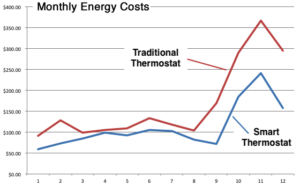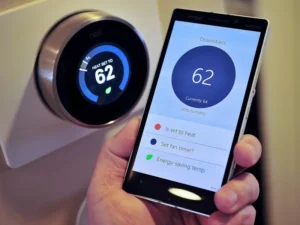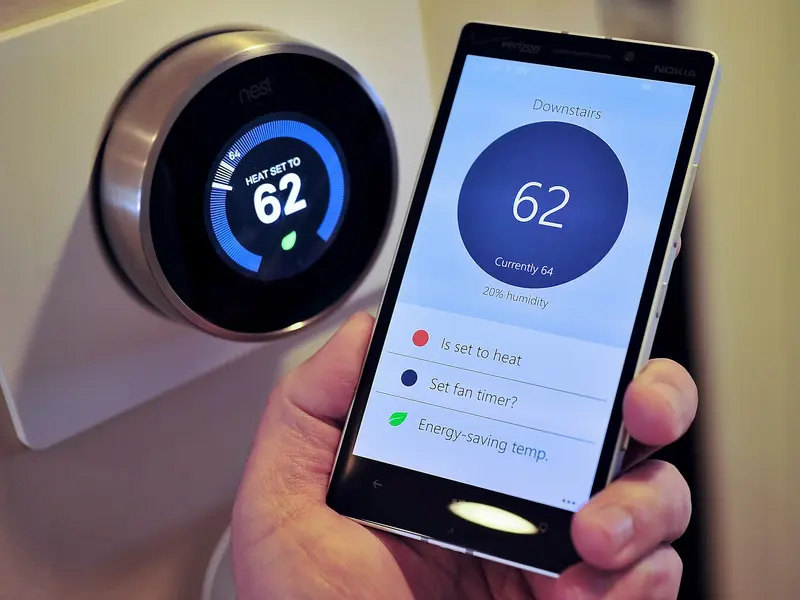Imagine being able to control your home’s temperature from your smartphone, automatically reducing energy use when you’re away, and receiving monthly insights on how to save more on your energy bills—all thanks to a single device.
Welcome to the world of smart thermostats, where convenience, efficiency, and savings go hand in hand.
But with so many options on the market and a range of price points, homeowners often wonder: Are smart thermostats really worth the investment? In this guide, we’ll explore the benefits of smart thermostats, including energy savings, convenience, and smart home integration. We’ll also cover thermostat installation costs and help you decide if upgrading to a smart thermostat makes sense for your home.
1. What Is a Smart Thermostat and How Does It Work?
A smart thermostat is an advanced thermostat that connects to Wi-Fi, allowing users to control it remotely via a smartphone app, tablet, or computer. Unlike traditional thermostats, smart thermostats have the capability to learn your heating and cooling preferences over time, automatically adjusting based on your schedule.
Key Features of Smart Thermostats
- Remote Access: Control your thermostat from anywhere, whether you’re at work, on vacation, or even across the room.
- Learning Algorithms: Many models “learn” your schedule and temperature preferences, adjusting automatically for optimal comfort.
- Energy Usage Insights: Receive monthly or even weekly reports detailing your energy use, along with tips on how to save more.
2. Smart Thermostat Benefits – Why Homeowners Love Them
- Energy Savings That Add Up
- One of the most popular benefits of smart thermostats is their ability to cut down on energy use. By automatically adjusting the temperature when you’re asleep or away, smart thermostats can reduce unnecessary heating or cooling.
- Energy Savings Stats: According to the Department of Energy, adjusting your thermostat by just 7-10°F for 8 hours a day can save as much as 10% on heating and cooling costs. Smart thermostats make these adjustments seamlessly, maximizing savings.
- Fun Fact: The Environmental Protection Agency estimates that homes with energy-saving thermostats could save up to $180 per year.
- Convenience and Control from Anywhere
- A major advantage of smart thermostats is the ability to control them from virtually anywhere. Forgot to turn off the AC before you left? Just open your app and adjust it remotely.
- Real-Life Example: You’re on vacation and realize you left the heating system on. With a smart thermostat, you can easily turn it down from your smartphone and save energy until you return.
- Smart Home Integration and Voice Control
- Many smart thermostats integrate with other smart home devices like Amazon Alexa, Google Home, and Apple HomeKit. This means you can control your thermostat using voice commands, making it part of a complete smart home ecosystem.

- Detailed Energy Reports and Personalized Recommendations
- With monthly or weekly energy reports, smart thermostats provide insights into your usage patterns, suggesting specific changes to help you save even more. Some models offer seasonal recommendations, automatically adjusting to seasonal weather changes.
- Environmentally Friendly
- By reducing energy waste, smart thermostats contribute to a lower carbon footprint. This makes them a great choice for eco-conscious homeowners looking to reduce their environmental impact.
3. Are Smart Thermostats Truly Energy-Saving?
While many homeowners report savings with smart thermostats, let’s explore exactly how these devices help cut energy costs.
Temperature Control for When You’re Away
Smart thermostats allow you to set schedules so that the temperature is automatically lowered (or raised in summer) when no one’s home, helping you save on energy costs. Many models have a “Home” and “Away” mode, which you can control manually or through location-based settings.
Pro Tip: Use geofencing settings on compatible models to automatically adjust the thermostat when you’re a certain distance from home.
Data-Driven Energy Optimization
With continuous monitoring, a smart thermostat gathers data on how often your system runs, outdoor temperature patterns, and the most comfortable temperatures for different times of day. This data allows it to make more accurate and efficient adjustments than traditional thermostats.
Seasonal Adjustments and Smart Learning
Many models include seasonal settings, adjusting automatically based on whether it’s winter or summer. Over time, some smart thermostats learn your habits and make proactive adjustments to further reduce energy costs.

4. Evaluating Thermostat Installation Cost
Factors That Influence Installation Cost
Installing a smart thermostat can be a straightforward DIY project or may require professional help, especially if the thermostat requires a “C-wire” (common wire) for power. Here’s a breakdown of factors that can impact installation costs:
- Compatibility with HVAC System: Some HVAC systems may require additional wiring or adapters for compatibility with smart thermostats, which can increase costs.
- Professional vs. DIY Installation: For simple wiring setups, DIY installation is often possible. However, professional installation ranges from $100 to $250 depending on your HVAC system’s complexity.
- Geographical Region: Installation costs may vary depending on where you live, with labor costs generally higher in urban areas.
DIY vs. Professional Installation: Pros and Cons
While many homeowners prefer DIY installation to save money, professional installation can provide peace of mind, especially if you’re unfamiliar with HVAC systems.
Pro Tip: If you’re considering a professional installation, ask your installer if they can offer a bundled package, including thermostat and installation, which can sometimes save on total costs.
5. Key Factors to Consider When Choosing a Smart Thermostat
- Compatibility with Your HVAC System
- Before purchasing a smart thermostat, check its compatibility with your HVAC system. Many thermostats specify the types of systems they work with, such as central air, heat pumps, and dual-fuel systems.
- Advanced Features and Smart Home Integration
- Some smart thermostats come with advanced features like humidity control, air quality monitoring, and multi-room sensors. If you have other smart home devices, consider a thermostat compatible with those systems for seamless integration.
- Real-Life Tip: If you use Google Home, Nest thermostats are a natural fit. For Amazon Alexa users, consider options like the Ecobee thermostat, which offers easy integration.
- User-Friendly Interface and App Functionality
- Since you’ll likely be using an app to control your smart thermostat, choose one with a user-friendly interface. Check reviews on app stores to see if the thermostat app has a high rating and reliable functionality.

- Price and Budget Considerations
- Smart thermostats range from around $100 for basic models to $300 or more for premium versions with advanced features. Determine which features are essential to you and choose a model that fits your budget.
6. How to Maximize the Benefits of Your Smart Thermostat
Optimize Schedules for Maximum Energy Savings
By setting schedules based on your daily routine, you can achieve smart home temperature control that adapts to your needs while saving energy. For example, set the thermostat to lower temperatures at night and while you’re away during the day.
Leverage “Away” Mode and Geofencing
Using geofencing, your smart thermostat can switch to “Away” mode when it detects your phone is a certain distance from home. This feature ensures energy is not wasted heating or cooling an empty house.
Fun Fact: Studies show that geofencing settings on smart thermostats can increase savings by an additional 10-15% on top of regular programming.
Take Advantage of Seasonal Settings and Updates
Many smart thermostats provide firmware updates that introduce new features and improve performance. Make sure your thermostat is set to update automatically so you can enjoy the latest enhancements.
7. Smart Thermostats and the Environment
By reducing energy waste, smart thermostats have a positive impact on the environment. Lowering household energy usage reduces carbon emissions, making these devices an environmentally responsible choice.
The Carbon Footprint Reduction Impact
A single smart thermostat can save hundreds of pounds of carbon emissions per year. For eco-conscious homeowners, this means contributing to a more sustainable future.





